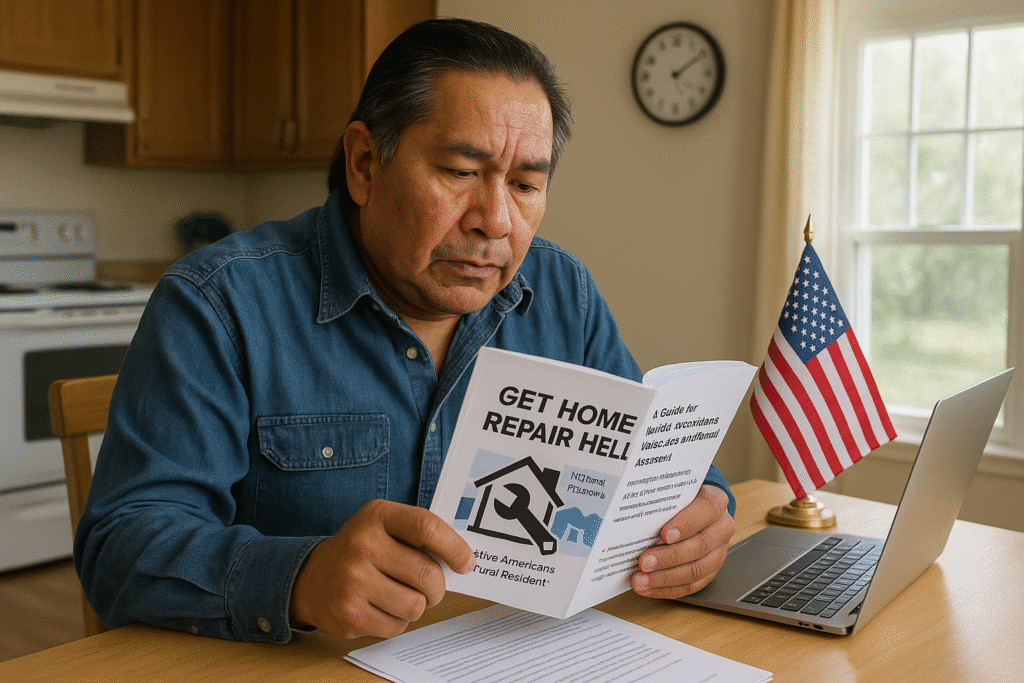Get Home Repair Help from the USA Government: If your home needs repairs — from a leaking roof to an accessible bathroom or a new heating system — you don’t have to go it alone. The federal government offers several targeted home repair programs for American Indian and Alaska Native families, veterans, and homeowners in rural areas. This practical, step-by-step guide explains who qualifies, how to apply, what documents you’ll need, and where to get fast, official help so you can move from “I need repairs” to “work is scheduled.”
Quick snapshot — which program fits you?
- If you are American Indian or Alaska Native: look into the Housing Improvement Program (HIP) administered by the Bureau of Indian Affairs (BIA) and tribal housing offices. HIP helps with repair/renovation, replacement, and modest new housing in many tribal service areas.
- If you are a veteran: the Department of Veterans Affairs (VA) offers disability housing grants (SAH, SHA), HISA grants for certain medically necessary home modifications, and other VA loan or refinance options that can free up funds for repairs.
- If you live in a rural area and have very low income: the USDA Section 504 Single-Family Housing Repair Loans & Grants program can provide low-interest loans and grants (grants for seniors) to fix health, safety, or accessibility problems.
All three sets of programs have distinct eligibility rules and application steps — but they share a common truth: start early, gather documentation, contact the official program office, and don’t fall for “free money” scams.
1) Home repair help for Native Americans: the Housing Improvement Program (HIP)
What HIP does
HIP provides grants (not loans) through the Bureau of Indian Affairs (BIA) or federally recognized tribes to repair, renovate, replace, or construct modest housing for American Indian and Alaska Native families who lack other basic housing options. The program is not an entitlement, so funding and rules vary by region and tribal administration.
Who typically qualifies
- Enrolled member of a federally recognized tribe (or a household that includes a tribal member, depending on tribal administration).
- Household with no immediate resources for decent, standard housing (tribal staff determine qualification and priority).
- Residency within the tribe’s approved service area (HIP is regionally administered).
How to apply (practical steps)
- Contact your tribe’s housing office or the regional BIA office. HIP is administered locally or regionally — your tribal housing authority will tell you whether they operate HIP and how to apply.
- Ask what documentation is required. Typical items include proof of tribal enrollment, proof of residence on eligible land, household income information, and photos/descriptions of needed repairs.
- Complete the application and follow the tribal/BIA process. Some offices have seasonal or limited funding windows — apply promptly and follow up.
- If you are unsure where to start, reach the BIA regional housing contact for guidance and referrals to tribal program managers.
Tips & red flags
- HIP is meant to help where there are no other housing resources — if a tribal program suggests a private “expediter” that asks for large fees to file the HIP application, treat that as suspicious. Tribal housing offices and BIA are the official routes.

2) Home repair and accessibility grants for veterans
Key VA programs you should know
- Specially Adapted Housing (SAH) — large grants to build or modify homes for veterans with certain severe service-connected disabilities (example: loss of both legs, certain burns, blindness combined with other disabilities). SAH grant maximums are updated yearly.
- Special Home Adaptation (SHA) — grants for veterans with certain permanent and total service-connected disabilities to modify an existing home to accommodate the disability.
- Home Improvements and Structural Alterations (HISA) — smaller grants intended for veterans who need medically necessary structural modifications but don’t qualify for SAH/SHA.
- VA loan and refinance options — cash-out refinancing or VA loans can sometimes be used to fund repairs; check VA loan rules and counseling.
Who typically qualifies
- A veteran or servicemember with the specific service-connected disability criteria for SAH or SHA, or with the medical need for HISA. Exact eligibility and benefit amounts are set by VA rules and annual updates.
How to apply and what to expect
- Gather proof of veteran status (DD-214 or VA ID) and medical documentation describing the qualifying disability or adaptive need.
- Download and complete the VA application form (VA Form 26-4555) for SAH/SHA or follow the VA guidance page for HISA; the VA website has detailed instructions and regional contacts.
- Submit the application to the VA regional office or via the contact methods on the VA housing assistance pages. For SAH, there are staff and phone support lines to guide you through the process.
- If eligible, the VA will authorize funds and provide guidance on approved contractors and project timelines where applicable.
Helpful practical notes
- SAH grant maximums can change year-to-year — check the current VA guidance for the latest dollar amounts.
- HISA grants are typically smaller and tied to specific medically necessary improvements; they are often processed faster but have smaller caps.
- Contact your local VA medical center’s prosthetics/housing coordinator or the VA housing assistance page for one-on-one support.
3) Single-Family Home Repair Loans & Grants (USDA Section 504) — for rural homeowners
What the program offers
USDA Section 504 provides direct low-interest loans and grants to very-low-income homeowners in eligible rural areas to repair, improve, modernize, or remove health and safety hazards from their homes. Grants are often available to homeowners age 62 or older who cannot repay a loan.
Typical benefit levels (examples)
- Maximum loan amounts and grant ceilings are published by USDA and can vary; illustrative figures: loans up to tens of thousands with low fixed interest (often 1% for direct loans), grants with lifetime caps for seniors. (Confirm current maxima with USDA.)
- Loans and grants may be combined up to program limits in special circumstances.
Who can apply
- Owner-occupants of qualifying rural properties who meet very-low-income thresholds for their county and who occupy the home as their primary residence.
- Home must be located in an eligible rural area (USDA field office can verify by address).
How to apply
- Contact your local USDA Rural Development office (the field office for your county). Field staff pre-screen for eligibility and provide application forms.
- Prepare documents: proof of ownership, photo ID, income statements (pay stubs, benefit letters, tax returns), and estimates for the repairs you need.
- Submit the application and follow the local review process. USDA field staff will tell you whether you qualify and the next steps, including environmental reviews if required.
Practical tips
- If you are elderly and low income, grants may be available and you may not need to repay.
- Some states/regions run pilot or updated versions of Section 504 — USDA field staff can point to the latest opportunity.
4) Cross-program strategies (when more than one program could help)
- Stacking and sequencing: If you are a veteran who is also a tribal member or a rural resident, you may be eligible for more than one program. For example, a veteran on tribal land might pursue VA disability grants and tribal HIP/tribal housing assistance — coordinate both offices so funds and work schedules make sense.
- Use loans strategically: Programs like HUD Title I, FHA 203(k), VA cash-out refinance, or USDA loans can be options when grants aren’t available. Loans have costs — compare interest and repayment terms carefully.
- Get professional counseling: HUD-approved housing counselors, VA case managers, tribal housing officers, and USDA field staff can help match you to the best program mix.
5) Documents you’ll commonly need (gather these early)
- Photo ID for adult household members (driver’s license, state ID).
- Proof of ownership (deed, mortgage statement, property tax bill) or land lease documentation for trust lands.
- Proof of income (recent pay stubs, Social Security/SSI/SSDI letters, tax returns).
- Proof of veteran status (DD-214 or VA ID) for VA programs.
- Proof of tribal membership or household inclusion in a federally recognized tribe for HIP.
- Photographs of damage/areas needing repair, contractor estimates if requested.
- Medical documentation for disability-based adaptations (for SAH/SHA/HISA and for some local programs).

6) Practical timeline — what to expect after applying
- Initial screening: within days to weeks after you contact the program office (depends on program and region).
- Document review and verification: usually 2–6 weeks, possibly longer if land title, environmental reviews, or medical verifications are required.
- Approval & contracting: once approved, funds are released per program rules — grants may pay contractors directly or reimburse you, loans are closed through participating lenders, and VA grants sometimes require certain contractor approvals.
- Project completion: contractor timelines vary; maintain communication and keep copies of all contracts and receipts.
7) Avoiding scams and bad deals
- The federal government does not solicit upfront fees to process grant applications. If someone asks for a large fee to “guarantee” a government grant, stop and verify with the official agency.
- Use only licensed, insured contractors. Get at least two written bids and check references.
- Get all agreements in writing. Government programs may require a bidding or vetting process; don’t sign away property rights or accept any contractor who asks you to do so.
8) Quick checklist — your immediate next steps
- Identify which group best describes you: Native American / Alaska Native, Veteran, or Rural homeowner.
- Collect basic documents: ID, proof of ownership, income statements, and photos of the repair needs.
- Contact the official program office (BIA/tribal housing, VA housing assistance, or USDA Rural Development field office) for pre-screening.
- Apply using the official forms and follow the office’s checklist; keep a copy of everything.
- If you’re unsure, contact a HUD-approved housing counselor or the local USDA/VA/BIA contact for guided assistance.
Helpful official links (click to open for full details and applications)
- USA.gov — Home repair programs for Native Americans, veterans, and rural residents:
https://www.usa.gov/home-repair-programs-special-groups - Bureau of Indian Affairs — Housing Improvement Program (HIP) information and regional contacts:
https://www.bia.gov (see regional HIP pages) — example regional page: https://www.bia.gov/regional-offices/great-plains/housing-improvement-plan - VA — Disability housing grants (SAH, SHA), HISA, and how to apply (including VA Form 26-4555):
https://www.va.gov/housing-assistance/disability-housing-grants/
Form & application info: https://www.va.gov/find-forms/about-form-26-4555/ - USDA Rural Development — Single-Family Housing Repair Loans & Grants (Section 504):
https://www.rd.usda.gov/programs-services/single-family-housing-programs/single-family-housing-repair-loans-grants - HUD — General home repair/rehab resources and HUD counseling locator:
https://www.hud.gov/topics/housing_advice and HUD housing counseling finder: https://www.hudexchange.info/programs/housing-counseling/find-a-housing-counselor/
Final thought
Getting home repair help from the U.S. Government is a real option for many Native American households, veterans, and rural residents — but the path is local, document-driven, and often administrative. The fastest wins come from: contacting the official program office, preparing your documents well, and working with a program caseworker or HUD-approved counselor who can guide you through the application and contracting steps.
Disclaimer: This guide is informational only and not legal, tax, or financial advice. Program rules, eligibility criteria, and funding levels change; always verify current requirements and application steps on the official program pages linked above before you apply. All images used in this article are royalty‑free or licensed for commercial use and are provided here for illustrative purposes.
